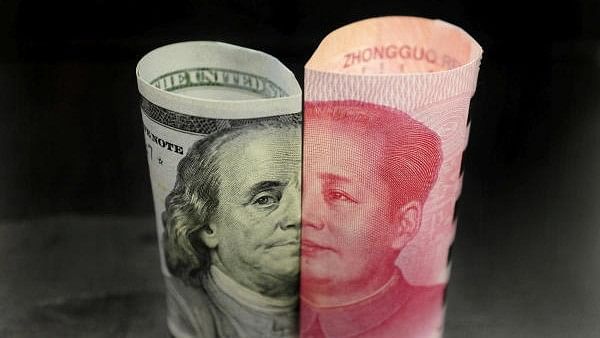
Benjamin Franklin US 100 dollar banknote and a Chinese 100 yuan banknote with late Chinese Chairman Mao Zedong are seen in this picture illustration
Credit: Reuters Photo
Beijing has a powerful tool for responding to President-elect Donald Trump’s threatened new tariffs on Chinese goods: It could start a currency war, a step that poses formidable risks for China as well as the United States.
Letting China’s currency, the renminbi, lose value against the dollar would be a tried and true answer to tariffs. A cheaper renminbi would make Chinese exports less expensive for overseas buyers, mitigating the harm to China’s competitiveness from Trump’s tariffs. Beijing did just that in 2018 and 2019, when Trump imposed tariffs in his first term.
A cheaper renminbi could partially or entirely offset the effects of the extra 10% tariff on Chinese goods that Trump said Monday he would order on his first day in office. He also said he would slap a 25% tariff on goods from Canada and Mexico, while demanding that they, along with China, halt flows of drugs to the United States.
A strategic devaluation of China’s currency, which is tightly controlled by the country’s central bank, could allow Beijing to supercharge its powerful export machine. China’s overall volume of exports to all destinations already surged nearly 12% in the first nine months of this year versus last year. China is poised for further gains, as its banks step up lending to build new factories.
But allowing China’s currency to fall could endanger the country’s economy. Confronting a weaker renminbi, Chinese companies and affluent families might rush to shift money out of the country instead of investing at home.
A weaker exchange rate for the renminbi against the dollar could also hurt the Chinese public’s confidence, undermine consumer spending and erode share prices. It could also work at cross purposes to recent efforts by policymakers to shore up the economy, which has been slammed by a housing market collapse that has erased much of the savings of China’s middle class.
China’s central bank, the People’s Bank of China, drew international criticism when it suddenly devalued the renminbi in August 2015, and has been wary of allowing such an abrupt move again. Liu Ye, the head of the international department, said at a news conference Friday that the central bank will “maintain the basic stability of the renminbi exchange rate at a reasonable equilibrium level.”
But China is deeply hostile to any new tariffs. Responding to Trump’s threat on Monday, the Chinese Embassy in Washington said: “China believes that China-US economic and trade cooperation is mutually beneficial in nature. No one will win a trade war or a tariff war.”
Chinese companies have substantially strengthened their manufacturing capacity in other countries in recent years, building factories that assemble components from China into finished goods for sale in the United States and elsewhere. This has allowed some of them to bypass tariffs imposed by the United States during the first Trump administration.
Many Chinese business owners have been moving money overseas in recent weeks to further beef up their foreign operations and make sure that China can maintain robust exports even if Trump imposes additional tariffs.
Wang Shouwen, China’s chief international trade negotiator, speaking at a news conference Friday, promised strong support for exporters. He said that China would provide more trade financing and export insurance for these companies.
China’s exports to the United States have stayed strong despite the 2018 and 2019 tariffs, as many Chinese companies have broken their exports into shipments small enough to avoid tariffs or tracking by customs officials. China has also increased exports rapidly to Southeast Asia and Mexico, where goods are then often processed and reshipped to the United States with little or no tariffs collected.
In the days after Trump’s election victory this month, the value of the renminbi slipped about 2% against the dollar. It has stabilized in the past week at around 7.25 renminbi to the dollar. Many other currencies have also weakened against the dollar since the election, not just the renminbi. The Mexican peso and Canadian dollar tumbled after Trump targeted both countries with potential tariffs.
The People’s Bank of China sets a daily band of exchange rates, buying and selling currencies in cooperation with state-controlled banks to keep the renminbi in a narrow range. Some currency market observers say that the state banks may be selling dollars now and using the money to buy renminbi, to preserve the current exchange rate.
Arthur Kroeber, a founding partner of Gavekal, an economic research firm, said that the renminbi could fall another 9% or 10% if the United States imposes steep tariffs on Chinese goods. That would mean nearly 8 renminbi would be required to buy a single dollar, a level not seen since 2006.
But many other analysts are skeptical that China would tolerate such a steep decline in the renminbi. They predict a floor for the currency at 7.3 to 7.5 per dollar.
China for many years was willing to allow the renminbi to remain weak to power its exports. But the central bank has begun to face an unusual ideological obstacle to any sharp weakening of the currency. At a rare gathering in January of Politburo members, ministers and provincial leaders, Xi Jinping, China’s top leader, gave a speech describing his vision for “high-quality financial development.”
Xi said that maintaining a strong currency was necessary for China to be a financial power, along with other key elements like a strong central bank and financial institutions.